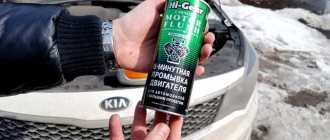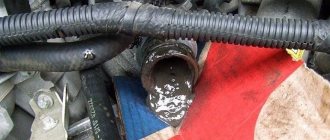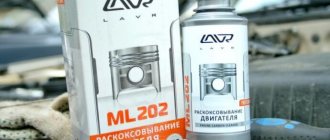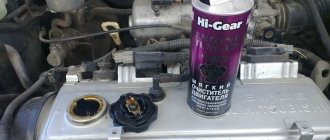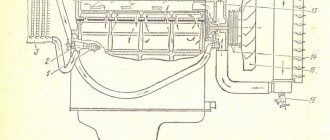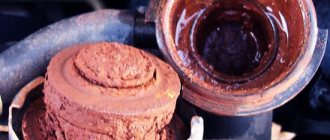There are fewer and fewer carburetor cars every year. Leading automakers have long switched to the injection type, which has a lot of advantages. This means lower fuel consumption, increased performance, a more balanced fuel-air mixture, etc. However, problems have also arisen. The injector is more expensive to repair; in addition, its injectors often become clogged, for which the “Lavr” product is often used to clean them. This flushing has its pros and cons, which we will talk about in this article.
Why does a car injector get clogged and how to deal with it?
Most chemical compounds found in fuel, such as sulfur, olefin and benzene, form tar deposits in the vehicle's fuel system. They cannot be removed with gasoline, as they are covered with a dense brown crust. The lower quality fuel is used, the more such deposits accumulate in the car over time.
It is quite logical that the overall efficiency of the car decreases, as the injectors become dirty. Due to the fact that complex injector flushing is a rather labor-intensive procedure, many people drive like this until a critical moment comes. The car will start to stall, the engine will run unstably, and some mornings you may not even start. To prevent this from happening, a liquid called “Laurel” is used. In this case, flushing the injector comes down to a few simple manipulations, which we will talk about in this article. It is also necessary to touch upon the engine cooling system.
Which oil system flushing do car owners choose - LAVR or Suprotek?
In October 2022, according to PartReview,
LAVR oil system flushes topped more auto ratings than Suprotek:
LAVR is chosen by owners of such cars as:
Ford Focus, Volkswagen Golf, VAZ (Lada) 2110/2111/2112,
and others.
Suprotek oil system flushes have not yet managed to take leading positions in car ratings. You can help if about this manufacturer, indicating your car.
Active additives - good or bad?
There are a large number of both supporters of chemically active components and those who categorically refuse to use them. Both the first and second are based on life experience, technical knowledge or simply expert advice.
First, you need to understand how flushing works on car systems. Let's highlight the main strengths and weaknesses:
- chemically active components, which can be called aggressive, have a negative effect on all rubber gaskets and seals. This leads to their accelerated wear;
- if the viscosity of the additive does not correspond to the viscosity of the oil, then its use is strictly prohibited, as indicated by the manufacturer on the packaging with flushing;
- Low-quality products for removing oil deposits only make things worse (they clog the catalytic converter, spark plugs), resulting in more problems than they are worth.
That is why not every car owner is satisfied with the result.
Why it's better not to experiment
Many people try to carry out various experiments with washings, which in most cases end sadly. For example, the concentration of the rinse is changed. There is no need to do this, since almost the entire point of using the product is lost. It does not give the desired result, but the money is wasted.
In addition, you should not fill in more than necessary, especially if there is little gasoline in the tank. This can lead to the fact that you simply won’t get to the gas station without incident. For example, soft washing “Lavr” at a high concentration has an extremely negative effect on rubber seals, which can subsequently result in replacing gaskets and seals, which is costly.
About the reasons for the appearance of coking
First of all, I would like to understand in more detail what contributes to severe engine contamination. The fact is that during the operation of the car, very often you have to drive at low speeds. This leads to carbon deposits forming on the valves and walls of the combustion chamber. Although in fact this is far from the only reason for the coking of an internal combustion engine, because there are a whole lot of them:
- use of low quality fuel;
- driving on a cold engine;
- using the wrong oil for the power unit.
All this gradually leads to more and more carbon deposits. Ultimately, the mobility of compression and oil rings is limited. This contributes to increased oil consumption, deterioration of engine dynamic performance and other problems.
Of course, Lavr decarbonization will help solve the problem. Consumer reviews confirm this. Let's figure out whether this domestic product is so good, how to use it and what we shouldn't forget about.
“Lavr” product: flushing the injector and engine
If you notice jerking in your car when driving, unstable engine operation, problems with starting in the cold season, then it’s time to use detergent additives.
All the work is quite easy to do yourself. To do this, a special product is poured into the gas tank every 5-6 thousand kilometers. True, such an event is carried out more as a preventative measure than as a “treatment”. Nevertheless, even owners of new cars need to do this regularly. As for “Laurel,” it is used somewhat differently.
What means are used to flush the engine?
Despite the fact that most washes act similarly, they are still divided into several classes. Among them:
- "Five minutes." As a rule, they are based on an organic solvent, which allows you to quickly and rapidly wash away dirt and deposits. The advantage of such products is their high speed of action. Disadvantages - along with dirt, the “five-minute” can wash away the lubricant from working mechanical pairs. As a result, scratches may appear on the parts. Therefore, such drugs can only be used when the engine is idling.
- Soft engine flushes. They are added to the oil approximately 100...300 kilometers before the scheduled oil change. They act more gently than previous products, since their base is created from calcium sulfonates (something like soap and similar detergents). In addition to the base, the composition includes dispersing additives.
- A mixture of the first two options. These can be a variety of compositions containing both solvents and detergent components with additives. As practice shows, universal tools are not as good as special ones tailored to solve a specific problem.
There is another class of rinses, which can conditionally be called folk, but they also belong to the “hard” class. For decades, before the advent of modern chemicals, motorists added various solvents, including acetone or solvent, to clean the oil system. This solution does exist, but with some limitations:
- The effect of such remedies is very limited in time. They are allowed to work literally for 3…5 minutes. Naturally, during this time they will only be able to wash off surface deposits.
- Under no circumstances should you increase the speed when there is such a flush in the engine!
As an example, we list several popular compounds belonging to certain classes (naturally, their true number is many times greater).
- “Five Minutes” - , , and EL TRANS Cleaner Oil System.
- Long-acting agents - .
- Universal means -, and.
Each of the listed rinses has its own characteristics of composition and use, so it is necessary to read the instructions!
Remember that all of the listed remedies are preventative and are not intended to decarbonize the engine. And also that before filling in new permanent oil, it is advisable to blow out the system using a compressor or use a vacuum pumping device in order to remove all remaining oil mixture in the engine (after traditional draining, about 200...300 grams always remain).
Sequence of actions when washing
First of all, we need “Laurel” - a soft engine flush. It is also advisable to have several liters of gasoline and a special watering can for filling. In the proportions indicated on the can, mix “Laurel” and gasoline, after which we find the tube going from the vacuum pump to the intake manifold, disconnect it and inject the mixture there.
It is necessary to start the engine and keep the speed within 2,500 thousand. At the same time, constantly add liquid to the tube. During this time, the engine will be unstable, but this is normal. Carbon deposits and large amounts of smoke may come out of the exhaust pipe. The exhaust at this time will be extremely toxic, so it is better for them not to breathe. We turn off the engine and let it cool, after which it is advisable to replace the spark plugs with new ones if they are no longer fresh. If the spark plugs are new, it is better to use old ones while washing them, as they are very likely to become coked.
How do five minutes work?
The principle of operation of 5-minute engine flushes is in the name. The general essence of how such products work is similar for all manufacturers.
Before changing the oil, five minutes is poured into the engine through the oil filler neck. Then the engine runs at low or medium speed for 5 to 30 minutes. After this, the used oil is drained. During this time, the additive actively dissolves sludge and varnish deposits and removes them along with used oil from the engine.
5-minute oils have several advantages over flushing oils:
- easier way to use;
- lower final cost of washing;
- a more pronounced effect when it is necessary to remove old deposits;
- The washing procedure takes a little time.
These funds also have disadvantages:
- excessively aggressive effect on the seals (if you leave the five-minute flushing in the engine longer than the regulated period, this can lead to destruction of the rubber seals).
- increased likelihood of a large slurry element peeling off from the internal surface of the internal combustion engine and getting into the oil channel (with subsequent limitation or complete cessation of oil flow through it).
Therefore, five-minute periods should be used carefully and only when necessary. For preventative flushing, it is better to use softer, high-grade flushing oils.
About the manufacturers of washes
One of the most popular liquids with the largest number of positive reviews is “Lavr”. This manufacturer has proven itself to be the best. This liquid must not be poured into the tank, as indicated on the label. According to owner reviews, the average rating for the liquid is 4 out of five. Many people say that you shouldn’t expect a miracle, but the product copes with its immediate task as it should.
Another popular one. Its cost is approximately the same as that of “Lavr” (a little more expensive, but not significant). As for the ratings, it’s also 4/5. True, experts say it is no worse than Winx, but less harmful to health. A product like High Gear is expensive, but it also cleans somewhat better. Well, now let's return directly to our topic.
Composition of flushing additives
To understand whether it is harmful for a car to use this kind of cleaning or not, you need to understand the components that wash the engine and injectors from carbon deposits. The main component is kerosene. It is an excellent cleaner for oil stains. For greater efficiency, chemically active detergents are added, which make it possible to almost completely remove oil deposits on the nozzle channels.
What are 5-minute engine flushes?
Five-minute engine flushes are a mixture of several main components.
- Light hydrocarbons. Oil distillation fractions, which have high volatility and penetrating ability, penetrate into the pores of sludge build-ups and break them down from the inside. They are especially effective in separating soot plaques in hard-to-reach cavities of internal combustion engines.
- Solvents. They work to decompose sludge and varnish build-ups separated from internal combustion engine parts into the smallest particles possible. Prevents the formation of large compounds from sludge. As a rule, these are also light fractions of hydrocarbons.
- Dispersants. Gently wash the internal surfaces of the internal combustion engine from varnish and sludge. They are mainly created on a calcium basis, similar in composition to detergent additives as part of a conventional additive package for regular motor oils.
- Surfactants. Increases the overall effectiveness of five-minute remedies.
Depending on the manufacturer, other substances are added to the composition of internal combustion engine flushes. As a rule, manufacturers do not disclose the exact list of components used in the production of cleaning additives.
About the car cooling system
When antifreeze turns an abnormal color, usually bright orange, there is rust in the system. In this case, it is necessary to flush the radiator and all channels. You can do this either independently or at a service station. “Lavr” is suitable as the main remedy. Flushing the cooling system will take quite a long time, since in case of severe contamination the situation will not be improved in one approach.
The first step is to drain the old antifreeze from the system. Next, take “Laurel” and fill one jar, then add distilled water to the minimum. We start the engine and let it run for about half an hour. After that, we drain it and see that there is a lot of rust in the pipes and radiators. It is advisable to repeat the procedure again in the same order. If rust still stands out, then at the third stage we simply use distillate, without rinsing. After the above procedures, fill in fresh antifreeze and enjoy the result.
Regular maintenance is the key to success
We have already figured out a little about what functions “Lavr” performs. Flushing the cooling system, injectors and engine - all this can be done with this product. However, do not forget that to achieve maximum results it is necessary to carry out regular maintenance.
For example, after cleaning the injectors they become dirty again, no matter how sad that may be. As a result, the situation repeats itself. To prevent this from happening, it is necessary to periodically use detergent additives, but not too often. When replacing antifreeze, which is done once every 12-24 months, it is advisable to flush the system as a preventive measure. In the same way, when replacing spark plugs with new ones, you can clean the injectors and the fuel system as a whole. It definitely won’t be superfluous, but you can sleep peacefully.
More important things
We have already figured out a little about how Lavr decarbonization is performed. You also know what it is and how it works. But I would like to highlight a few rather important details that are rarely talked about. The fact is that ideally, decarbonization should help increase the compression of the power unit. But sometimes the opposite happens - compression drops.
This often happens on old engines with significant mileage. The wear of piston group parts in such an engine has long exceeded all standards, and carbon deposits act as a seal between the cylinder and the piston. When decarbonization is carried out, carbon deposits are removed. This leads to a drop in compression. Consequently, a major overhaul of the power unit is approaching. Therefore, it is impossible to speak with 100% confidence about the benefits of flushing the engine. In one case, decarbonization can significantly delay major repairs, in another - vice versa.
“Laurel”: flushing the cooling system. Consumer Reviews
The most reliable way to ensure the quality of a product is to test it for yourself. However, this approach often leads to dire consequences. For this simple reason, before using flushing, you need to look at what car enthusiasts or service station specialists write about it.
As for “Lavr”, today it is one of the most popular means in Russia along with “High Gear” and “Winx”. Flushing, according to reviews, has excellent cleaning properties and is not too aggressive towards rubber seals, although it has a negative effect on them.
What do drivers advise?
Oddly enough, many motorists prefer to use “soft” decarbonization. This is a less effective method and more time-consuming. However, it does not require any effort from you. You just need to pour a certain amount of liquid into the fuel tank and drive on. The carbon deposits, although it takes a long time, gradually burns out, and the higher the load on the engine, the faster and better the washing process proceeds, at least, this is what numerous reviews say. The decarbonizing agent "Lavr" from a domestic manufacturer is inexpensive, but its effectiveness is no worse than "Liqui-Moli" or "High-Gear", which are several times higher in price.
Moreover, motorists are most neutral towards rubber seals and gaskets. But still, you shouldn’t use it too often, as oil seals and old gaskets may not hold up. But it is still necessary to understand that if there is too much production, then decarbonization will no longer help. Yes, this method can delay the overhaul of the power unit, but ultimately it cannot be avoided.
Injector contamination level
As practice shows, not every car owner maintains his car on time. This usually leads to even more serious consequences. An example is injectors. They are responsible for uniform injection of the fuel-air mixture into the cylinder. Over time, both the cylinder and the injectors become coated with carbon deposits, resulting in reduced engine performance. Experts distinguish three degrees of injector contamination:
- 5-7% - almost imperceptible to the driver, since there are no signs of malfunction. Fuel consumption increases slightly.
- 10-15% - twitching is noticeable while driving, a drop in dynamic characteristics, and fuel consumption increases.
- 15-30% is a critical level. Gasoline consumption increases significantly, the engine sputters at idle, and most often stalls when cold.
Based on the above points, we can conclude that the first stage is not so critical, in addition, only an experienced specialist can detect the malfunction. But the lack of action on the part of the driver leads to the second, and accordingly, the final stage. Here the situation is more serious and requires special attention.
LAVR Motor Flush Soft 200 km – detergent additive for oil
STATED FEATURES
The detergent additive LAVR Motor Flush Soft 200 km (LAVR soft flushing) is poured into the engine oil system 150–200 kilometers before changing the oil. One package of the drug is designed to flush the oil system of an engine with a volume of 4–6 liters. According to the manufacturer, the additive most carefully removes varnish, bitumen and grease-like deposits in the engine oil system. At the same time, thanks to dispersants, it protects the engine from premature wear and prevents clogging of channels and filters. The additive rejuvenates rubber seals and gaskets and is compatible with all types of motor oils.
APPLICATION FEATURES
Before using a detergent additive in LAVR Motor Flush Soft 200 km oil, it is necessary to warm up the engine to operating temperature. After this, pour the additive into the oil filler neck and start the engine. Let it idle for 5 minutes, then start driving the car. After 150–200 kilometers, replace the oil filter and add new oil.
TEST RESULTS
Laboratory research has shown that the additive in LAVR Motor Flush Soft 200 km oil contains trace elements: calcium Ca - 24 mg/kg, magnesium Mg - 0 mg/kg, boron B - 1 mg/kg, zinc Zn - 10 mg/kg and phosphorus P – 12 mg/kg.
The additive in LAVR Motor Flush Soft 200 km oil contained only traces of additive elements, but not the additives themselves. From the obtained result we can conclude that this is an organic solvent, and it is advisable to drive 150–200 km after adding it to the engine at idle speed.
Protecting the system after cleaning
There is no need to talk about the quality of domestic fuel. Often, fuel contains a large amount of impurities that exceed all possible standards and environmental tolerances. In some cases, gasoline is diluted, which has a detrimental effect on the fuel system of a modern car. If we add to all this the difficult operating conditions of the internal combustion engine (traffic jams, long-term operation, overheating), then it’s not far from a breakdown. It’s good if you use Lavr engine flushing, reviews of which confirm its effectiveness. But few people use this remedy regularly.
In order for the “iron horse” to work properly, it is advisable to protect the system with special liquids immediately after flushing. If you follow the advice of experienced specialists and the car manufacturer, you can significantly extend the life of important components of the car. This applies to the cooling system, fuel, brake, etc.
Let's sum it up
So we figured out how to do and why you need to wash the injectors. “Lavr”, reviews of which all boil down to the fact that the product is worthy of attention, copes with the task completely. However, we must not forget that overuse of such a chemically active liquid can lead to “eating” of rubber seals and seals. For this simple reason, you need to follow the instructions and not come up with anything unnecessary.
Really high-quality washing “Lavr” - reviews repeatedly confirm this. The domestic manufacturer does not produce the product at the lowest cost, but recently its effectiveness has been higher than that of Winx. Also, experts prefer to work with Laurel, which is not surprising, given the health harm caused by Winx.
Operation of the injector will be problem-free if you periodically monitor and clean the system, and also use the “Lavr” flushing fluid. Please note once again that you cannot pour “Lavr” into the tank if it is written on the label! If you do not have any experience in flushing the injector and cooling system, it is better to let specialists do this. But even here you need to be confident in the services of the service station, since there are often cases when they took money from the driver, but did not do their job, and if they did, it was done poorly. Therefore, always be vigilant.
Some general information
Currently, there are a huge number of products for cleaning a car engine. There are both foreign and domestic manufacturers who have proven themselves well. In this article I would like to talk about the domestic product for decarbonization - “Lavra”. Reviews about it are more than positive, and many motorists prefer this particular flush. But I would like to immediately note that if the vehicle’s engine needs major repairs, then cleaning it with “Lavr” or any other similar means will no longer help. Only a major overhaul will solve the problem here.
It is worth drawing your attention to the fact that decarbonization can be done with your own hands. There is nothing complicated here, although a lot depends on the design of the car. The more modern it is, the longer it will take. But decarbonization is often performed on engines that have already run a fair amount and are heavily contaminated with carbon deposits. Typically, motorists do the washing themselves, because this will save some money and do everything conscientiously.
